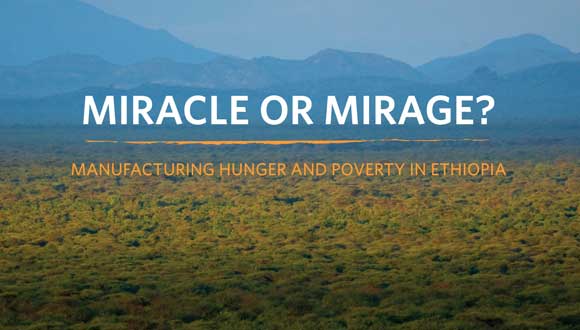Ethiopia: Rising African Lion Or Broken Dictatorship?
Earlier this year, the World Bank, in an enthusiastic account, praised “The Ethiopian Way” as an exceptional model, responsible for the country’s “successful development performance.”

This accolade appears to be a case of amnesia, ignoring the severe political crisis that the country has plunged into since last year. Protests, stay-at-home strikes, and many other acts of resistance – including Olympic medallist Feyisa Lilesa’s widely broadcasted denunciation of the government – are a powerful rejection of the Ethiopian government who jails its political opponents, muzzles the media, and is responsible for widespread violations of human rights and development schemes that have led to land grabs.
Ethiopia's Broken Development Model
The donor-praised “Ethiopian Way” is a blatantly broken development model. Miracle or Mirage, Manufacturing Hunger and Poverty in Ethiopia, a new report, concludes that despotic development policies have only perpetuated cycles of poverty, food insecurity, and marginalized the most vulnerable Ethiopians.
A decade of double-digit economic growth has failed to curtail chronic food insecurity in the country. An average of 11.6 million Ethiopians have depended on food or cash handouts for their survival each year, over the past twelve years – with the numbers peaking over 18 million in 2016.
Millions of those affected by the crisis are poor farmers, pastoralists, and agro-pastoralists, victims of mass displacements to make way for foreign and government-led large-scale agriculture projects and ‘development schemes.’
Human Rights Abuses and Displacement: Foundation of Ethiopia's "Development" Plans
These forced displacements and related human rights abuses of over 1.5 million people to avail fertile lowlands to agribusiness investors, constitute the foundation of Ethiopia’s plans for “development.” This strategy stems from its failure to learn from country’s past. Over the past few decades, displacement of Afar people, to establish large-scale sugar and cotton plantations in the Awash Valley, took away some of the best dry-season grazing lands from the pastoralists and triggered deadly famines.
Today, the government is blindly pursuing similar policies. With the hopes of making Ethiopia one of the largest sugar producers in the world by 2023, the Lower Omo Valley has been targeted for massive sugar expansion. The Omo-Kuraz Sugar project, comprised of up to five sugar factories and 150,000 hectares of sugarcane plantations, will rely on Gibe III Dam for irrigation, ignoring its irrevocable negative consequences. The reduction of Omo River flow by as much as 70 percent will destroy the livelihoods of 200,000 Ethiopians and 300,000 Kenyans who depend on the downstream water flow for herding, fishing, and flood-recession agriculture. In its quest for development for a few, the government is also in denial that pastoralist livestock production is far more profitable than large-scale sugar and cotton plantations.
The evidence that Miracle or Mirage presents makes it imperative that there be a fair and a truly democratic debate within Ethiopia on its development policies such as these destructive and costly agricultural schemes – sugar expansion will require $11.2 billion in investments by 2020 and Gibe III alone cost Ethiopia $1.8 billion. Instead, democracy has been thwarted and opposition criminalized.
The ongoing repression of the opposition and willful blindness to the negative impacts of large-scale agriculture schemes sets the stage for repeating fatal development schemes on a much larger scale. The Ethiopian government and its Western allies – donors who have bankrolled the country with some $3.5 billion of aid per year since 2008 – need to immediately overhaul the “Ethiopian Way.”
